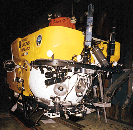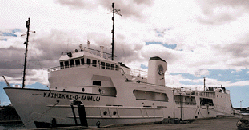
Recent Activity at Loihi Volcano

Events during 4 Aug to 10 Aug 1996
Current Geologic Activity and Research at Loihi
Visit these Recent Activity Links Too:

The information below was provided by UH Scientist Fred
Duennebier (Chief Scientist)
and Frank Sansone (Co-Cheif), and the other scientists aboard the
R/V Ka'imikai-o-Kanaloa presently on station over Loihi,
as well as by UH Scientist Ken Rubin on shore.
10 Aug 1996: No direct news was received from the ship, although
the Honolulu Advertiser daily newspaper reports having had a
discussion with Dr. Jennifer Reynolds of HVO aboard the ship after the
second Pisces V submersible dive.
More evidence for extensive
tectonism on Loihi's summit was observed. Bottom waters were apparently
very murky, with visibility dropping to less than 2 meters in places.
These conditions prohibited extensive exploration of the new terrain,
as well as limited the extent to which hydrothermal fluids
or rocks could be sampled.
Although there was extensive rubble on the summit,
there was no clear evidence for fresh extrusive lavas that would
have been produced during a summit eruption. This fact may be due to
the limited time for exploration of the summit and the difficult
conditions that sub pilot Terry Kerby had to navigate through.
The lack of evidence on the summit for extrusive volcanism is, however,
also consistent with scenrarios proposed by UH Professor Mike
Garcia on the Loihi
Event Summary page, wherein lavas are drained from a crustal
magma reservoir in the summit area to feed an eruption on the
volcano's flanks. This action would cause the unsupported top
of the volcano to then collapse inward, producing vast amounts
of rubble and debris, but no summit lavas. Future exploration of
the volcano, particularly on areas of the flanks that are deeper
than 2000m water depth (the working limit of Pisces V) will
hopefully reveal additional clues as to just what happened at
Loihi the past few weeks.
9 Aug 1996: Divers on the submersible Pisces V examined the summit
region of the volcano yesterday, including the new pit crater formed some
time in the very recent past. Particle-laden water was found in the vicinity
of the latter, similar to conditions found by other reseachers visiting
submarine mid-ocean ridge volcanoes in the aftermath of eruptive activity.
Of note as well from the dive at Loihi yesterday was the presence of
sediment on the summit region consisting of white, sand-sized particles of
unknown composition and volcanic glass.
In the weeks and months following this expedition, a great deal of
shore-based work will be conducted by researchers at the UH and elsewhere, to
document the pysical, chemical and biological processes occuring during and
after a submarine volcanic eruption. Collectively, this information should
add substantially to our limited but growing knowledge of volcanic
activity in these remote submarine areas of our planet.
One such study involves age determinations of lavas suspected of having been
erupted during recent weeks. A number of small samples of basalt
have been collected, but their relationship to the seismic events of the last
few weeks is only circumstantial at this point. UH Scientist Ken Rubin will
use analyses of radioactive isotopes 210Po and 210Pb to determine
the age of the samples to a potential resolution of 1 week.
More information on the
210Po-210Pb technique, described in an
article published in Nature in 1994, is avaiable on our web
server for those that are interested in such things.
8-9 Aug 1996: This report was received at 6:21AM HST on 9 Aug
from the UH ship stationed at Loihi seamount:
Loihi Rapid Response Expedition Press Release #3
August 8, 1996 9 PM. Hawaiian Std. Time (abord the R/V Kaimikai O Kanaloa)
Scientists aboard the R/V Kaimikai O Kanaloa dove today in the
PISCES V manned submersible to the summit of Loihi seamount
to study first hand the effects of the seismo-volcanic event that
began about 3 weeks ago. Earlier in the cruise they detected a
new crater at the summit of Loihi where Pele's Vents, an active
hydrothermal area, had been. The sea floor has dropped from
980 m below sea level to about 1280 m, nearly 1000 feet.
During the dive today, scientists landed the sub near the highest
point of the seamount (PISCES peak) and worked their way slowly
towards the new pit crater through murky waters, with visibility
less than 5 feet at times. Most of Loihi's surface consists of large
broken boulders and parts of basaltic pillows. Several areas along
the 2 mile route display fresh surfaces uncovered by large
landslides or shaking likely due to recent earthquakes. Older
surfaces are light brown while fresh surfaces are nearly black.
While traversing the edge of West Pit, a previously existing
pit crater on the western side of the summit, several glassy fist-
sized rocks were recovered that had been thrown out of the crater
together with glassy black sand. As this deposit is very thin and
present only in a few patches, it is thought to be the result of a
landslide on the other side of West Pit that threw debris across the
crater and onto the opposite rim.
A visit to Pele's Pit, the new pit crater detected by shipboard
instruments, showed that it is indeed there, and that the Pele's
Vents area was destroyed by this crater-forming event. The pit is
nearly filled with a cloud of murky water. West Pit has been
enlarged considerably by this activity and now connects with
Pele's Pit.
A strong current blows material across Loihi from the
northeast to southwest, thus the source of this murky water is
likely to be towards the east of where the dive took place today.
Tomorrow's dive will attempt to locate the sources of this water
with a dive to the eastern side of the Loihi summit.
Water samples collected during today's sub dive will be used to
verify theories being made on the geochemical reactions
responsible for the extremely large temperature, salinity, and
chemical anomalies measured in the seawater above Loihi. These
seawater anomalies are being tracked by the scientists by towing
sensors and sampling gear through the water. These
measurements, called "tow-yos", are being conducted from the
ship throughout the night.
8 Aug 1996: This report was received at 7:13AM HST on 8 Aug
from the UH ship stationed at Loihi seamount:
Loihi Rapid Response Expedition Press Release #2
August 8, 1996 6 AM. Hawaiian Std. Time (abord the R/V Kaimikai O Kanaloa)
Yesterday and throughout last night scientists were raising and
lowering instruments in the water, mainly looking for anomalies in
water temperature and chemistry. and also listening for sounds
that might indicate that an eruption is occurring. Except for the
area around the peak of Loihi, the sounds and water appear to be
quite normal, but towards the southern end of the summit region
the ocean water is considerably warmer than usual, charged with
carbon dioxide, and loaded with particles suspended in the water,
which are strong signs of eruptive activity. This "plume" of warm
water is among the most intense ever recorded in the ocean.

|
Sonobuoys, which broadcast sounds back to the ship by radio from
underwater microphones are picking up crackling and grinding
noises in the summit area which could easily be sounds of an
eruption in progress.
As the weather remains favorable, earthquake activity has
subsided, and a good target for diving has been identified, the 3-
man PISCES V submersible (left) will dive today at about 8:30 AM to collect
samples of vent waters and rocks in the active area, returning to
the ship at about 4:30 PM today.
|
6-7 Aug 1996: This report was received at 5:47AM HST on 7 Aug
from the UH ship stationed at Loihi seamount:
Loihi Rapid Response Expedition Press Release #1
August 6, 1996 11 PM. Hawaiian Std. Time (abord the R/V Kaimikai O Kanaloa)
An interdisciplinary team of researchers from the University of Hawaii
are studying the effects of ongoing intense seismic and volcanic activity at
Loihi seamount, 20 miles southeast of the Island of Hawaii. The reseachers
and collaborators from the Bishop Museum, the University of Washington,
and the U.S. Geological Survey Hawaiian Volcano Observatory, report being
rocked by several earthquakes felt through the hull of the research vessel,
the Kaimikai O Kanaloa, as they steamed over the volcano.
On their first pass over the volcano, the researchers noted that an
area called Pele's vents, where active hydrothermal venting had been
recorded by previous cruises, was no longer there. Pele's vents, which
used to reach a depth of 980 meters below the ocean surface, is now the
site of a new pit crater 260 meters in diameter and 300 meters deep, roughly
the same size as similar craters at Kilauea volcano.
Water samples recovered from the area near "Pele's puka", the new pit
crater, are 2.5 degrees C warmer than the surrounding water and are highly
acidic, indicating that they contain nearly as much carbon dioxide as they
can hold. The water samples are milky brown in color because of suspended
fine particles of what is probably volcanic glass. These characteristics,
along with other chemical indicators, imply that the samples were taken very
close to an active underwater volcanic eruption.
The researchers plan to continue their National Science Foundation funded
"rapid response" mission through Friday, and hope to conduct a dive to the
eruption site with the manned submersible PISCES V if safety can be assured.
The dive will place a seismometer on the ocean floor to be recovered on a
later cruise and recover samples of the fresh volcanic rocks and vent
waters. Additional research will further define possible changes in the
shape in the volcano and look for other possible eruption sites.
5 Aug 1996: The event response expedition to Loihi seamount left
Honolulu Harbor at 0700 today for 6 days of exploration and monitoring
at Loihi.

|
A tentative schedule
is available, but this will likely change
depending on early results obtained by the science party and
weather conditions.
The ship will not be in constant email contact with
the shore but we are expecting daily updates (to be posted here).
|
4-5 Aug 1996: In the past 2 days, only two
earthquakes have been recorded by the Hawaii Volcano Observatory
(HVO) network with magnitudes greater than 4 (data source: NEIS
World Wide seismic network). This represents a slowing down of dramatic
seismic activity recorded in the previous two weeks, and may either signal
a change from mostly tectonic to mostly effusive volcanic processes or
an overall reduction of activity of any sort at the volcano.
UH Scientists Fred Duennebier and Ken Rubin provided
information used on this WWW document.

 Return to the Hawaii Center for Volcanology LOIHI Page
Return to the Hawaii Center for Volcanology LOIHI Page
 Return to the Hawaii Center for Volcanology Home Page
Return to the Hawaii Center for Volcanology Home Page
This page created and maintained by
Ken Rubin,©
krubin@soest.hawaii.edu
Last page update on 11 August 1996







![]() Return to the Hawaii Center for Volcanology LOIHI Page
Return to the Hawaii Center for Volcanology LOIHI Page
 Return to the Hawaii Center for Volcanology Home Page
Return to the Hawaii Center for Volcanology Home Page
